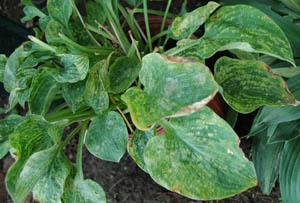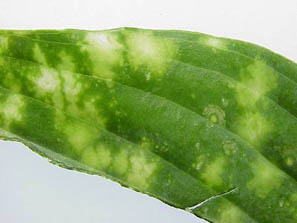Odd-Looking Hostas | |
|---|---|
| September 30, 2008 | |
|
You can visit a garden center, the Internet, or your friends’ gardens and find hundreds of hosta choices. The variation in color and form seems limitless. Beware, however, that some of the symptoms you are seeing could be the result of a viral infection. Hosta viruses may cause stunted growth and various odd leaf color patterns. Often, the leaves are abnormally thickened and obviously malformed. Other times, the leaf patterns are actually attractive. Ringspots, mosaic, speckling, and discoloration may be present. The images show hosta infected with hosta virus X and tomato ringspot viruses.   The tomato ringspot virus image is from Agdia, Inc. Some viruses that infect hosta include cucumber mosaic virus (CMV), hosta virus X (HVX), tomato ringspot virus (ToRSV), tomato spotted wilt virus (TSWV), impatiens necrotic spot virus (INSV), tobacco rattle virus (TRV), and arabis mosaic virus (ArMV). Virus particles cannot grow on lab media, and they cannot be seen with a compound microscope. The good news is that viruses can be detected with specialized enzyme-linked immunosorbant assays called ELISA tests. Fresh, symptomatic leaf tissue is needed for the ELISA test. Dry leaves may not provide conclusive results. If symptoms suggest viruses, a private lab offering serological testing is suggested for positive identification. The University of Illinois Plant Clinic can test for many of these viruses. Another lab that can help is Agdia, Inc., in Elkhart, Indiana. There are images of hosta infected with several viral diseases on their Web site (www.agdia.com) under “slide show.” If sending plant material across state lines, call first to determine whether a form is required with the sample. The United States Department of Agriculture, Animal and Plant Health Inspection Service, has strict regulations in this regard. Why are viruses the most difficult hosta diseases to control? Viral diseases cannot be eradicated from a plant. Unlike people, plants do not have immune systems, so the virus is in the plant for life. Simply removing a few symptomatic leaves does not eradicate the disease. Sometimes, the effect of infection is minor. In most cases, the infected plants need to be removed and destroyed, roots and all. The means of transmission varies with the virus, so a positive identification is helpful for disease management. INSV is transmitted by thrips, as well as mechanically. Tobacco rattle virus is transmitted by nematodes, mechanically, and in seed. Hosta virus X is transmitted in sap, so it may be spread when dividing plants, trimming foliage, and working with plants. Carefully inspect any hostas that are planted into your gardens or those produced in your nursery. Do not propagate or plant those with viral disease symptoms or those that “look funny.” Beware of reduced-priced plants that you might want to nurse back to health. If purchased, these plants should be isolated until health is regained. Only then should they be planted into the garden. Sometimes new hosta varieties are propagated from plants with genetic mutations that look interesting. Beware that such plants may be infected with a virus. If you decide to propagate one of these oddities, keep it isolated from other plants until it has been shown to stay vigorous, and it has been tested for known viruses. | |
| Author: | Nancy Pataky |
